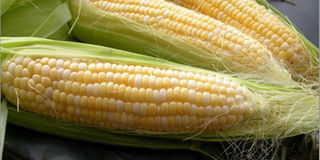Prime
Maize prices increase as middlemen hoard it

Maize is the most widely grown staple crop in Africa – more than 300 million Africans depend on it as their main food source – and it is severely affected by frequent drought.
Cereal dealers hoarding maize grain in anticipation of its shortfall has led to increase in market prices, exerting surmountable pressure on industries depending on the grain.
Industry insiders say escalating prices and commodity shortages will hit hard on storage and exporting companies, the animal feed industry and consumers –practically the poor.
The only winners will be small scale middlemen who bought maize from farmers at a cheaper price and now aim at doubling profits.
According to John Bosco Ssenengo, who runs an animal feed shop in Kisenyi, maize prices have averagely increased by Shs300 per kilogramme in the last two weeks and figures are expected to double by mid next month.
“The commodity supply has extremely reduced, causing a price increase. A Kilo of maize now costs between Shs1000 and Shs1100 compared to the Shs700 we were paying per kilogramme two weeks ago,” Mr Ssenego says.
He says the scenario has affected prices of all maize products whereby a kilo of maize brand now cost Shs500 from shs300, a week ago. “Traders are hoarding the grain because they foresee supply shortages in the near future. Here, some have stocked more than 100,000 kilogrammes as they wait for prices to rise to Shs1500,” he adds.
The commodity price increase will be mostly felt by consumers and farmers since animal and bird feeds are predicted to go up by 20 per cent. Interestingly, wholesale dealers and farmers say they are not benefiting from the price upsurge and are totally locked out of business.
Mr Vincent Monterio, Sunrise Commodities and Millers general manager, says some companies have suspended buying the commodity because their customers (both national and international) are not willing to purchase it at high prices.
“Buying the commodity at a high price means that we will also have to sell it expensively after adding value on it. But since maize is still in plenty in the East African region region, customers are not willing to buy it expensively. They choose to buy it from Kenya or Tanzania where maize is relatively cheap,” Mr Monterio explains.
Here in Uganda, World Food Programme is one of the major buyers.
Mr Monterio also blames escalating prices and shortage in supply on Kenyan traders who penetrated deeper in villages in search for the commodity. He says Kenyans inflated the price to Shs750 from Shs350.
“This caused panic among middlemen who rushed to stock the commodity. They (middlemen) have now stocked it in anticipation that prices will soon increase to Shs1, 500, just like it was in the same period last year,” he notes.
Of recent, maize has become one of Uganda’s major exports beating some traditional cash crops such as cotton. Statistics from the Uganda Export promotion Board show that maize exports are increasing each year. The country shipped 156,586 tonnes of maize worth about Shs95.5bn ($38.2m) to different destinations in 2010. Previously, the country received about Shs72.5b and Shs45b from the crop exports in 2009 and 2008 respectively.
Currently, most of Uganda’s maize is exported to Kenya, Southern Sudan and other East African countries. There are claims that the country’s crop has also found market in Ethiopia, which has started consuming maize.
Mr Lukanga Kanamwangi, Semuto-Kapeeka Farmers Association chairperson, says farmers lost the game by selling off their grain hurriedly at cheap prices. He explains that majority of the farmers sold maize at Shs300 and Shs400 due to lack of storage facilities.
However, due to delayed March rains and crop failure, experts predict that prices will remain the same. Mr Monterio explains that continual hoarding of maize by small-scale middlemen will affect the quality of the commodity since such traders have no capacity to store the crop.




